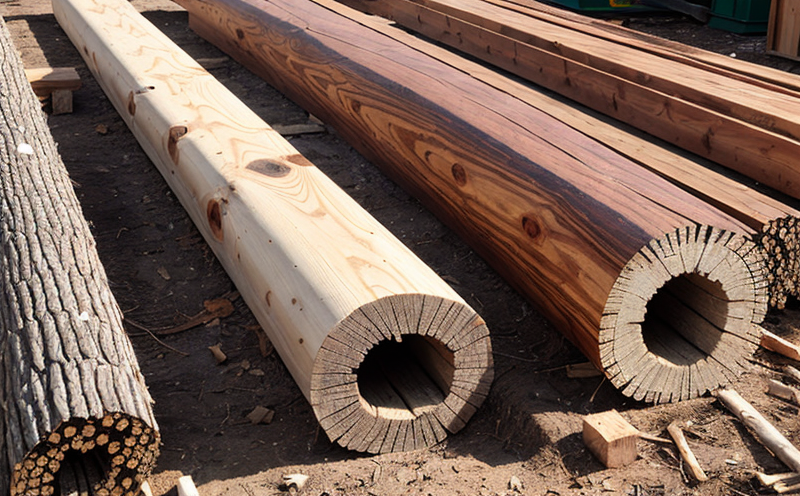Moisture Absorption Resistance Testing in Treated Wood
The moisture absorption resistance testing of treated wood is a critical process that ensures the durability and longevity of wood products used in various sectors, including agriculture, construction, and forestry. This test evaluates how well a treated wood product resists water absorption, which can significantly impact its performance under different environmental conditions.
Wood preservation involves treating raw timber with chemicals to protect it against decay caused by fungi, insects, and other microorganisms. The effectiveness of this treatment is often determined through moisture absorption resistance tests. This test measures the amount of water absorbed by a treated wood sample over time. The standard used for this purpose is ISO 11408:2017, which provides guidelines on determining the resistance to water absorption of wood and wood-based materials.
The process starts with selecting the appropriate specimen size and shape that represents typical field conditions. Specimens are then prepared by soaking them in a standardized solution for a set period before being dried at specific temperatures and relative humidity levels. After drying, these specimens are subjected to a series of immersion cycles where they are exposed to water under controlled conditions.
The absorption rate is calculated based on the mass gain observed during each cycle. A lower absorption rate indicates better resistance against moisture penetration, suggesting that the treatment was successful in providing protection. This information is crucial for quality managers and compliance officers who need to ensure their products meet regulatory standards and perform optimally under real-world conditions.
For R&D engineers involved in developing new preservation methods or improving existing ones, this test provides valuable data on material properties and how they interact with different treatment processes. Understanding the absorption behavior helps refine formulations and application techniques, ensuring maximum protection while minimizing environmental impact. Procurement professionals also benefit from such tests as it allows them to compare suppliers and choose materials based on their resistance capabilities.
By conducting these tests rigorously, laboratories like ours contribute significantly to maintaining high standards within our sector. Our expertise ensures accurate results that can be relied upon by stakeholders across various industries relying heavily on wood products.
Industry Applications
Moisture absorption resistance testing in treated wood finds extensive application across multiple sectors where wood is used extensively, such as agriculture and forestry. In these fields, the ability of treated wood to withstand moisture exposure directly influences its performance and lifespan.
In agriculture, treated wood structures like fences, posts, and support beams need to endure harsh weather conditions including rain, dew, and occasional flooding. By ensuring that the wood used in such applications has high resistance against water absorption, farmers can expect longer-lasting infrastructure which reduces maintenance costs and improves operational efficiency.
The forestry industry also benefits greatly from this testing method since it plays a vital role in preserving natural resources while meeting growing demand for timber products. Treating wood with appropriate chemicals not only extends its useful life but also allows it to be used more sustainably by reducing waste generation and promoting recycling practices.
Moreover, treated wood is increasingly being utilized in green building projects aimed at reducing carbon footprints and enhancing energy efficiency. The moisture absorption resistance testing helps architects and builders select suitable materials that not only perform well under challenging environments but also contribute positively to environmental goals.
Environmental and Sustainability Contributions
The importance of moisture absorption resistance testing in treated wood cannot be overstated, especially when considering its positive impacts on the environment. By ensuring that treated wood products have adequate resistance against water absorption, we help reduce unnecessary waste generated from premature degradation.
Incorporating sustainable practices into timber harvesting and processing processes is becoming increasingly important globally. Through rigorous testing, we contribute towards achieving these objectives by providing accurate assessments of material performance. This allows for the creation of more efficient production methods that minimize resource consumption without compromising quality or safety standards.
Furthermore, promoting the use of durable treated wood in various applications fosters a circular economy model where resources are reused effectively rather than discarded after short lifecycles. This approach aligns with broader sustainability initiatives aimed at reducing waste and enhancing overall resource management.
The results obtained from moisture absorption resistance testing play a key role in guiding decisions regarding material selection, design optimization, and lifecycle assessment. By leveraging this knowledge, stakeholders across different sectors can implement strategies that promote sustainable practices while maintaining the integrity of their operations.
Use Cases and Application Examples
One notable example where moisture absorption resistance testing in treated wood is particularly relevant is in the construction industry. For instance, consider a project involving the installation of wooden beams intended to support large structures exposed to constant humidity levels due to their proximity to bodies of water or coastal areas.
In this scenario, it would be essential to know how well these beams will resist water absorption over time. The testing process would involve preparing specimens representing the actual size and shape used in construction before subjecting them to immersion cycles according to ISO 11408:2017 standards.
The outcome of this test provides valuable insights into whether the chosen treatment method effectively protected the wood against moisture intrusion. Such information is invaluable for architects, engineers, and project managers who aim to balance aesthetic considerations with practical requirements.
Another application lies within agricultural settings where treated wooden fences are required to maintain their integrity despite frequent exposure to water. By conducting thorough moisture absorption resistance tests, farmers can ensure that these structures remain effective barriers against livestock while withstanding the elements year after year.





